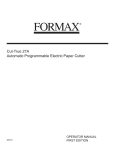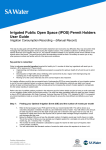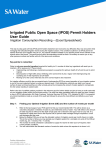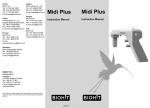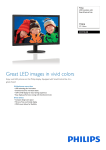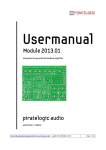Download ADU2a User Manual
Transcript
ADU2a User Manual 1. 2. 3. 4. Safety Precautions It is important to make sure that the measurement subject is protected against any possible hearing damage. Therefore, one should always go by the following safety precautions: 1.) the noise of the scanner should be dampened by using double hearing protection: earplugs/eartips of the correct size, please make sure that the plugs/tips are properly inserted into the ear canal, and external earmuffs, which should fit tightly and cover the whole earlobe. The effectiveness of the eartips should be beefed up with tufts of cotton wool (the area/volume inside the earlobe is filled with cotton wool). Additional attenuation of the scanner noise can be achieved by installing sheets of Eterlon Formax FX-65S on both sides of the 8 channel EXCITE brain coil and by covering the orange tubes carrying the stimulus sounds to the eartips with a towel. 2.) The sound volume of the stimuli should not be too high. One should start with very low volume level and, if needed, increase the level of volume with great care, so that the sound level will never be too loud. Also, the subject should always be informed that he/she must report immediately, if the stimuli or the noise from the scanner feels unpleasantly loud. The volume of the stimulus sound, and thus the maximum SPL (Sound Pressure Level) of the whole sound system, is dependent on the amplification set in the Denon and Lab.Gruppen amplifiers, recording level of the original sound signal and volume settings in the stimulus PC. If you are uncertain of the correct procedures, please, contact AMI personnel for more information. Equipment used for auditory stimulation in the AMI Centre ADU2a Stimulator The ADU2a stimulator consists of an electrodynamic transducer unit and 5 meters of silicon tube, one set for each ear. The transducer and related stimulator electronics are shielded in an aluminum box. The sound is transmitted from the transducer as an acoustical signal through plastic and silicon tubes to the subject’s ear using replaceable porous eartips at the end of the tubes. In the tubes there are marks to indicate, which tube is left/right. The transducer elements are protected with a thermal resistance to prevent the stimulator units from over-heating due to excessive input power. If the thermal resistance is activated it takes a while before the transducer units become functional again. The researcher should not feed any signal to the stimulators until the thermal resistors have cooled down. 1. Stimulus PC & CD/DVD player At AMI Centre the most commonly used sound source is stimulus PC (Windows 98, SoundBlaster sound card). From the stimulus PC soundcard the signal is led to a Denon AVR 1802 audio amplifier. The connection between PC and amplifier is optic to prevent the formation of humming sound caused by ground currents between the devices. Another sound source connected to the Denon amplifier is a NAD CD/DVD player. Also the CD/DVD player output is connected to the amplifier input optically. The frequency response of the ADU2a stimulators is limited below 10 kHz. Hence, the stimuli should not contain frequencies above 10 kHz. When a high-frequency stimulus is played at high intensity the resulting sound has a nonlinear distortion and may even break the transducer elements. Currently, the frequency range of the stimuli have to be limited below 10 kHz before the signal is fed to the ADU2a stimulators (i.e., when creating the stimuli), but in the near future, an analog low-pass filter will be added to the ADU2a system. To reach the maximum output volume of the ADU2a system the input signal must be recorded at the maximum level in the wave file and the PC volume settings should be at the maximum position. 2. Denon Amplifier To use the sounds from the stimulus PC, select the input marked as “STIM-PC” in the front panel of the Denon amplifier. For the NAD CD/DVD player, use the input marked as “CD/DVD”. You can also use the internal tuner of the Denon amplifier by selecting the input marked as “RADIO”. The Denon amplifier can be used to define the sound pressure level with respect to individual hearing threshold. First, the hearing threshold is determined by adjusting the amplification. Second, desired SPL over threshold is added. However, in a noisy environment, such as the MR scanner room, the hearing threshold is shifted upwards which should be taken into account when adjusting the volume. The dB scale of the Denon amplifier is linear from -55 to 10 dB, but user should only use volume range from -55dB to 0dB, because higher volumes may cause hearing defect. One should make sure that both speakers A and B are switched off in the amplifier front panel in order to get the output to the ADU2a system! 3. Audio System Selector Sound signal is lead from the amplifier front panel stereo headphones connector to an audio system selector and further to the audio stimulator systems. In audio system selector, there is a switch to select ADU2a stimulator. 4. Power Amplifier (Lab. Gruppen) The signal is led from the audio system selector to a Lab.Gruppen iP 900 power amplifier. Because the input resistance of the ADU2a transducer elements is 8 Ω the maximum output power from the amplifier is 99.4 W. The maximum power that the ADU2a elements can tolerate is 100 W. The signal amplification is mainly adjusted from the Denon amplifier. In that case the gain of the Lab.Gruppen amplifier is kept at 0 dB. However, the gain of both left and right channels can be separately adjusted from the Lab.Gruppen amplifier. In this case, the output SPL should be adjusted to a comfortable listening level with the Denon amplifier while the Lab.Gruppen is kept near the maximum value (e.g. around -10 dB). Thereafter, the channels can be separately finetuned with Lab.Gruppen amplifier.





